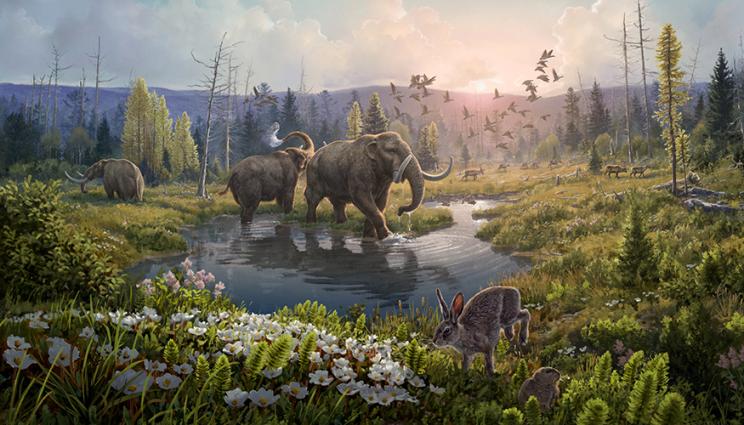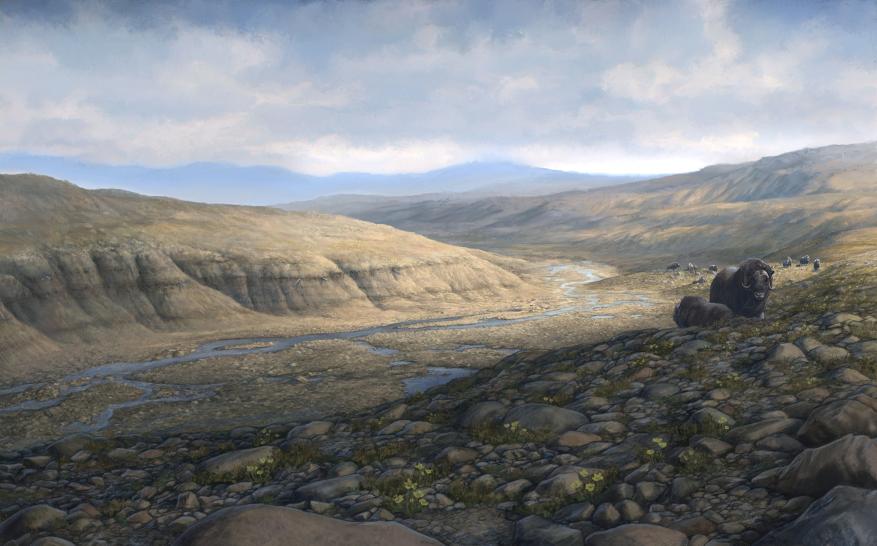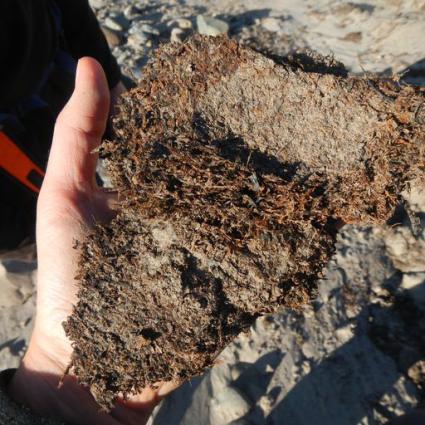
Reconstruction of the Kap København formation two-million years ago, in a time where the temperature was significantly warmer than northernmost Greenland today. Image by Beth Zaiken.
Around 2 million years ago, climate in Greenland resembled the forecast of a future under global warming: with trees such as poplars and birch and animals like hare, lemmings, mastodons and reindeer.
Paleoclimatic records show strong polar amplification with annual temperatures of 11-19 degrees Celsius above current values. The biological communities inhabiting the Arctic during this time remain poorly known because animal fossils are rare.
An international team, including a researcher from Lawrence Livermore National Laboratory (LLNL), report the oldest ancient environmental DNA (eDNA) record to date, describing the rich plant and animal assemblages of the Kap København Formation in north Greenland that existed 2 million years ago. The research appears on the cover of the Dec. 7 issue of Nature.
The ancient DNA has been used to map a two-million-year-old ecosystem, which weathered extreme climate change. Researchers hope the results could help to predict the long-term environmental toll of today's global warming.
This section of Greenland is now a polar desert, but the new research shows that wasn't always the case. More than 2 million years ago, the summer and winter average minimum temperatures of 10 degrees Celsius and 17 degrees C, respectively, were more than 10 degrees C warmer than present day.
The higher temperatures likely caused the Greenland Ice Sheet to melt, possibly producing one of the last ice-free intervals in the last 2.4 million years. Though the region has well-preserved macrofossils from a coniferous boreal forest and insects, few traces of vertebrates have been found.
That's where the new research comes in. The 3.4 million old Fyles Leaf bed and Beaver Pond on Ellesmere Island in Arctic Canada preserve fossils of mammals that potentially could have colonized Greenland, such as the extinct bear (Protarctos abstrusus), giant beavers (Dipoides sp.), the small canine (Eucyon) and Arctic giant camelines (c.f. Paracamelus0).
Using LLNL's Center of Accelerator Mass Spectrometry, researchers analyzed isotopes of beryllium and aluminum found in the soil to constrain the age of the sediment containing the environmental DNA. LLNL's Alan Hidy worked on the age interpretation and modeling of that data.
"The DNA we collected is considerably older than any previously sequenced DNA," Hidy said. "Our DNA results detected five times as many plant varieties as previous studies using shotgun sequencing of ancient sediments, which is well within the range of the richest northern boreal metabarcoding records."
The detection of both reindeer, caribou and mastodon calls for a revision of earlier paleoenvironmental reconstructions based on the site's relatively impoverished faunal record, entailing both higher productivity and habitat diversity for much of the deposition period. All the vertebrate taxa identified by DNA are herbivores - caribou, geese, hares and rodents - and can all be abundant, at least seasonally, in boreal environments.
The authors concluded that the power of ancient eDNA adds "substantial detail to our knowledge of this unique, ancient open boreal forest community intermixed with Arctic species, a community composition that has no modern analogues. Similar detailed flora and vertebrate DNA records may survive at other localities. If recovered, these would advance our understanding of the variability of climate and biotic interactions during the warmer Early Pleistocene (Ice Age) epochs across the high Arctic."
Other institutions involved in the research include University of Copenhagen, University of Cambridge, the Globe Institute, Faculty of Health and Medical Sciences, Université Savoie Mont Blanc, Université Gustave Eiffel, Halsnaes Kommune, Rådhuspladsen, Geological Survey of Denmark and Greenland, Russian Academy of Sciences, Uppsala University, Dalhousie University, The Arctic University Museum of Norway, The Arctic University of Norway, Carlsberg Research Laboratory, University of Oxford, Oxford, Curtin University, University of Grenoble-Alpes, Univ. Savoie Mont Blanc, 18Institut de Biologie de l'Ecole Normale Supérieure and MARUM, University of Bremen.








